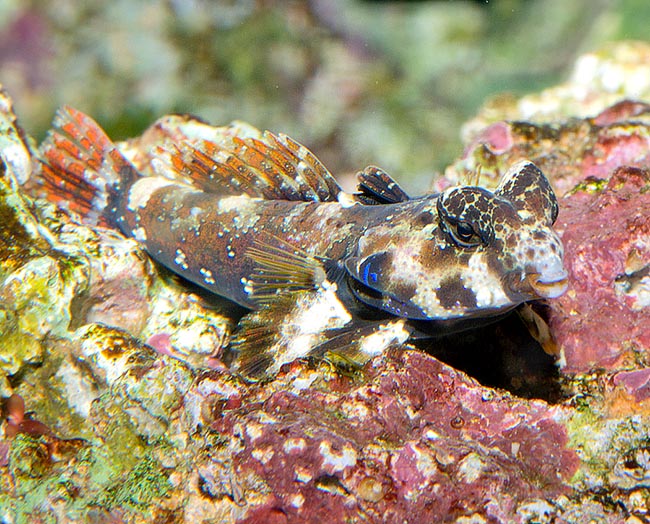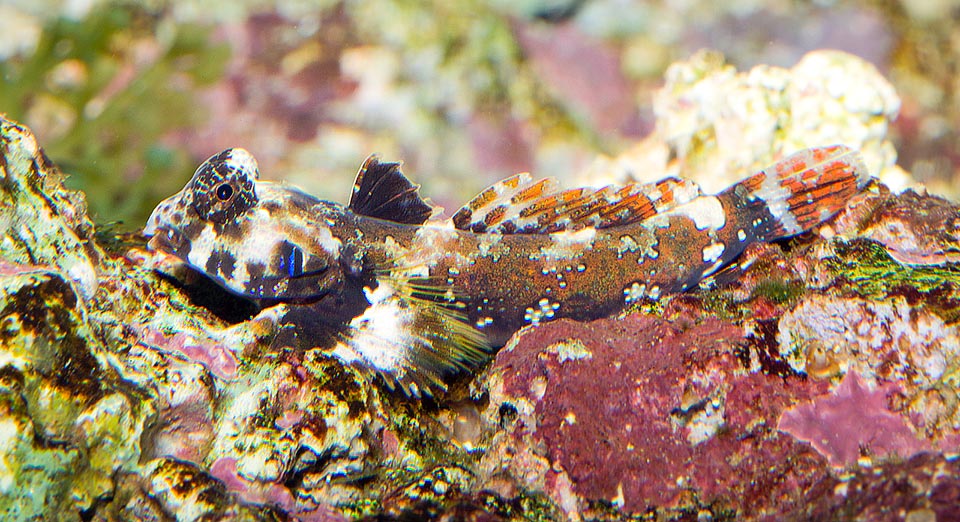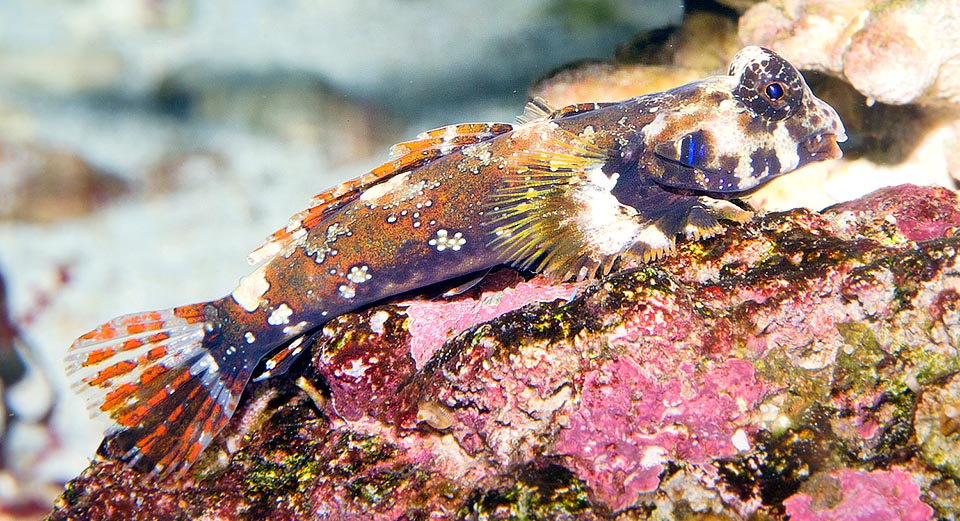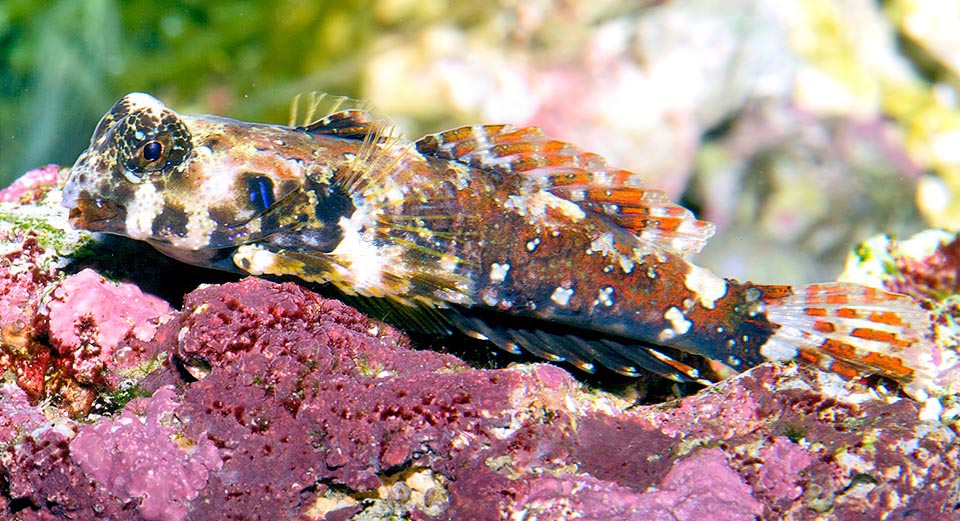Family : Callionymidae

Text © Giuseppe Mazza

English translation by Mario Beltramini

Similar to a small dragon Neosynchiropus ocellatus is scaleless with triangular head and protruding eyes © G. Mazza
Master in mimicry, the Ocellated dragonet (Neosynchiropus ocellatus Pallas, 1770) belongs to the class of Actinopterygii, the ray-finned fishes, to the order of Perciformes and to the Callionymidae, a family of benthic fishes that, evolutionarily talking, is close to Gobiidae.
It counts about twenty genera and almost 200 species commonly called dragonets due to their unusual look, without scales.
Under the skin, on the preoperculum, they have on both sides a big sharp spine that causes painful wounds, long to heal, hence the recurrent name of spider fish.
The genus Neosynchiropus comes from the Greek “νέο” (neos) = new, “συν” (syn) = with, “χείρ” (cheir) = hand and “πούς” (pus) = foot, to tell us that, as happens for the similar genus Synchiropus, the fins are used also as “feet” for moving among the madreporic formations on the seabed.
The specific name ocellatus, comes from the Latin “ocellus” = eye, with reference to the drawings on the first big dorsal fin of the males, and to the numerous mimetic ocelli of the livery.
Zoogeography
The ocellated dragonet has an ample distribution in the Indo-Pacific tropical waters. Indicatively, we find it from Vietnam, Indonesia and Australia we meet it north-east to Philippines, Taiwan, Ryukyu Islands and Japan and south-east to the Palau Islands, in Papua New Guinea, Micronesia, Wake Islands, Marshall Islands, Solomon Islands, Fiji Islands, New Caledonia, Tonga Archipelago, Samoa, French Polynesia, Marquesas Islands and Pitcairn Islands.

Mimicry master, has 4 spiny rays in the first dorsal fin and a big sharp spine under skin in the preoperculum evidenced by a blue trait © Giuseppe Mazza
It moves on the bottom, along the slopes of the madreporic formations up to about 30 m of depth.
Morpho-physiology
It rarely exceeds the 8 cm with an elongated and cylindriform body. The eyes are close and protruding on the head that, seen from above, reveals triangular and pointed, just like a dragonet. The mouth is protractile with various rows of tiny teeth. There are two dorsal fins and as happens for the Synchiropus picturatus and the Synchiropus splendidus the first, that has 4 spiny rays, is more developped in the males. The second has 8-10 soft rays. The anal fin, with 7-9 rays, has no spines, like the ample pectoral, that have 18-23 rays and the ventral ones on which it walks. The caudal fin is rounded.

Rarely exceeds 8 cm. The pectoral fins, as well seen in the photo, have adapted to deambulation © Giuseppe Mazza
Ethology-Reproductive Biology
The ocellated dragonet lives in small groups nourishing of the benthic microorganisms it finds on the detrital seabeds, the weeds and the corals. These are mainly ostracods and harpacticoid copepods, but also eggs of mollusks and fishes or swimming larvae of various species. For the marriage the spouses go up to the surface embraced, belly to belly, and after the fecundation they entrust the floating eggs to the currents.

It nourishes jumping on small crustaceans without ignoring the eggs and the swimming larvae it finds on the seabed. It is not endangered © Giuseppe Mazza
The resilience of the species is excellent: in fact are sufficient 15 months to fill the losses in populations decimated by the events. The pressure exercised by the aquaria market is practically zero and however may the things go the Neosynchiropus ocellatus will always find something to eat. The vulnerability indesx of the species is very low: just 13 on a scale of 100.
Synonyms
Callionymus ocellatus Pallas, 1770; Synchiropus ocellatus Pallas, 1770; Callionymus punctulatus Lacepède, 1800; Callionymus microps Günther, 1877; Synchiropus lili Jordan & Seale, 1906; Synchiropus shoe Okada & Ikeda, 1937; Synchiropus rhodonotus Fowler, 1946.
→ For general information about FISH please click here.
→ For general information about BONY FISH please click here
→ For general information about CARTILAGINOUS FISH please click here.
→ To appreciate the BIODIVERSITY of BONY FISH please click here.
→ To appreciate the BIODIVERSITY of CARTILAGINOUS FISH please click here.
